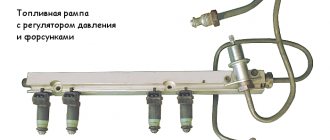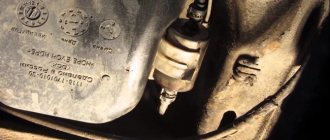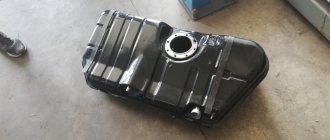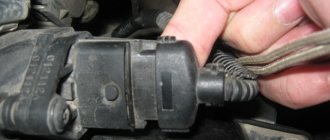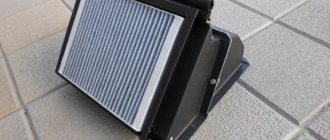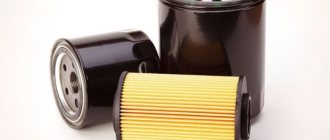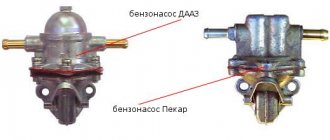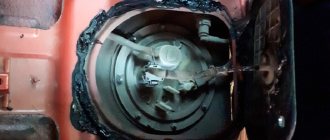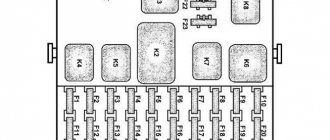How to clean a fuel pump
The fuel tank is the main location of the fuel pump. Its operating principle is that the control unit, immediately after turning off the ignition, forces the gasoline pump to turn on and continue its operation for some time. And this makes it easier to start the engine next time.
The crankshaft position sensor is activated when the engine rotates. The control unit immediately starts the gasoline pump when receiving the signal. But if this signal is not received from the sensor, the gasoline engine, as well as the electric pump, will be stopped. This property increases the battery life. There is a separate relay that helps control the pump in the control unit. If the fuel pump does not turn on, then the first thing to check is the relay.
The uniqueness of Nissan Almera (Nissan Almera) is that the fuel pump has an integrated design, which has a filter designed to clean the fuel. Replacement can only be done together, that is, assembled, since the structure cannot be separated, because it is one-piece.
But this operation is expensive. As a result, we can suggest cleaning the fuel pump on your Nissan. (Although if you still decide to replace the fuel pump, the steps are almost identical to preparing for cleaning).
To clean the fuel pump, you first need to remove it.
Basic faults
- Filter clogged.
- Sensor malfunctions.
- Failure of the electric motor.
- Damage to the plastic housing.
In accordance with these breakdowns, the fuel pump is repaired on the Nissan Almera H16.
Causes of failure
You can extend the life of your fuel pump if you know what affects its operation.
The pump operating time can be reduced by:
- Low quality fuel.
- Driving with an empty tank.
- Interruptions in the car's electrical network.
- Debris getting into the pump.
- Depressurization of the housing.
Removing the fuel pump
First you need to remove the rear seat element. The gasoline pressure must be relieved in the fuel line. The fuse box, which is located under the dash on the driver's left side, must be open. There is usually a marking on the top (cover) that makes this fuse easy to find as it is labeled FUEL PUMP. It should be in the second column (fourth from the top), and also have the designation 15A. The fuse must be removed from the socket. Start the car, and after 3-5 seconds the engine will stall on its own. This action must be repeated until the engine no longer starts (this usually works after 3-5 attempts). After that, wait a minute and repeat the steps. If everything is done correctly, the pressure will be released almost to the limit, that is, to the end.
If you do not want to find the fuse, you should disconnect the connectors from the flange (located under the seat) of the fuel tank. There is no need to remove the hoses immediately.
You need to remove the filler cap and then relieve the internal pressure in the gas tank. We unscrew the three black plastic bolts and remove the hole cover for inspection. Afterwards, the large plastic nut must be unscrewed by hand. We should be able to see a white glass, where the fuel pump is installed. This is a cylinder measuring 10 by 3 centimeters. Some models have an internal mesh, which is usually yellow with dirt.
The return hose must be removed by accurately pressing the plastic latch. This hose extends from the beginning of the engine, as well as an arrow that is directed to the fuel pump. With a little pressure, approximately one small glass of gasoline will flow out of the hose. The second hose will also need to be disconnected, but in this case nothing will leak out. The most important thing is that you need to be careful so that they are not damaged when removing them.
The connector with the harness must be removed and the fuel level meter, that is, the float located in the tank, disconnected. And then you need to remove the fuel pump itself.
Now you can start cleaning the fuel pump itself.
Step-by-step guide to replacing the Nissan Almera fuel filter
When all the necessary things are prepared and the fuel filter is waiting in the wings, we begin work.
- The first step is to remove the back seat. This is done simply. We find the latches, press them, pull them up.
- The next step is to relieve pressure in the fuel system. Open the fuse cover. They are located on the left side, directly under the torpedo. Use tweezers or any sharp object to carefully remove the fuse. Then we start the engine and wait patiently for it to stall. This algorithm must be repeated two or three times, with a break of a minute.
- Then you have to remove the fuel tank cap. To do this, open the hatch where the neck of the fuel tank is hidden and unscrew the cap. So the pressure in the tank has been relieved.
- Now you need to unscrew the cap above the fuel pump. You will need a wrench. Using it, unscrew the three bolts securing the inspection hole cover. Under the cover there is a fuel pump and a fuel filter.
- The next step is to inspect the fuel pump.
- Now you need to remove the return hose. Remember that you need to prepare the container before doing this. A very large amount of gasoline will be spilled.
- Disconnect the chip with wires. Simply press the two latches and pull the hose off the pipe.
- Next, as many as six bolts await us, which need to be unscrewed, using either an 8 key or a Phillips screwdriver.
- We get the fuel pump.
- Disconnect the gasoline hoses from the fuel pump.
- You need to remove the sensor and float, and then the casing from the fuel pump.
- We install a new one where the old fuel pump was. We connect the hoses to it.
- We return all the removed parts to their places and do not forget to return the fuse to its original position. This completes the replacement of the fuel filter successfully.
Cleaning the pump
Attention! If this procedure does not produce results, then replacing the fuel pump is inevitable.
You should disconnect the fuel hose (it is always rigid), as well as the sensor and do not forget about the float. Then you need to bend the latches (there are 3 of them) of the pump casing. There, below, under the casing, there is a filter.
After cleaning, you need to assemble it all in the opposite order.
Materials used in these operations:
- rags (required quantity);
- small basin;
- a small glass, approximately 300 ml, to collect gasoline flowing from the hose;
- a fire extinguisher is a must (you never know what can happen);
- cleaning products (acetone, liquid intended for washing the injector).
This procedure takes an hour or two on average. Doing the work yourself can save you quite a bit of money, but it will get you a lot dirty.
How often to change the fuel filter and pump on Almera Classic
According to the factory recommendations for the operation and maintenance of Almera Classic, there are no specific intervals for replacing the gasoline filter. Its resource is designed for the entire service life of the fuel pump, which changes over a mileage of one hundred to two hundred thousand kilometers. The fuel filter and pump are replaced as an assembly.
When carrying out independent maintenance of the fuel system, when the filter element is replaced separately, replace it at intervals of 45,000-60,000 km.
Pump relay
Knowing the exact location of the fuel pump relay in the Nissan Almera H16 is not so important. The element in H16 should be looked for on top of the fuse block, that is, on the cover. The most important thing is that under the hood the relay is located in a block. This rule applies to both Nissan Almera Classic and Nissan Almera N16.
How often should the fuel filter be changed?
The manufacturer itself does not give specific dates, but recommends replacing filters along with the fuel pump. In Russia, owners of Nissan Almera Classic usually change both elements after 15-20 thousand kilometers, that is, more often than required, since they have to drive on low-quality fuel.
Sometimes there is a need to urgently replace filtration devices. You should be concerned when there are signs such as dips and jerks during engine operation. Dips are especially noticeable at speeds above 90 km/h. In this case, a tripping effect occurs when the motor operates in different ranges.
Relays in various versions of Nissan Almera
The fuel pump relay is usually located in the engine compartment; in this case, the marking of this element will be K5. The compartment will be located to the right of the battery, meaning on the passenger side. The lid is held in place with latches that are very easy to snap off. There is one more place where the required element can be located - this is the safety block. It is located next to the driver's right foot. There is a plastic cover that will need to be opened to access the relay. This relay is mainly blue in color.
Which filter should you choose?
Original filters are not sold separately. You can only buy the part together with the pump module. There are many analogues. Some even install filters from our “ten” or VAZ-2112. However, in the latter case, you have to slightly modify the installation part. Sometimes you also need an original cuff to seal the module cover. This component is damaged if the cleaning devices are not removed carefully.
Branded trainers from Hyundai Accent can also serve as substitutes. They differ from the original. In particular, this concerns the location of the mounting points of the pressure regulator (valve). The element will fit as desired if you lengthen the valve using a hose or slightly trim the module shell.
How to determine a fault in a relay
The main sign of problems in the operation of the fuel pump is the failure of the pump, that is, it simply does not turn on. If the fuel pump on the Nissan Almera N16 does not turn on, then you should not immediately go for a new one; you should check the relay, which, most likely, is the main problem. You can check this assumption by replacing the relay with another one, which you don’t have to buy, since you can use what you already have.
We repeat, but this is important: if the fuel pump does not work, then you should check the relay, since in most cases this is where the whole problem lies.
How to identify a malfunction
The main signs of a fuel pump failure are:
- The car does not start well and does not start the first time.
- The engine stalls during short stops.
- The engine idles rough.
- The car accelerates slowly and reacts poorly to pressing the gas pedal.
- Extraneous noise is heard in the fuel tank area.
If these symptoms appear, it is better to repair the pump immediately to avoid further damage.
In some cases, it is not repair that is required, but cleaning or replacing a clogged fuel filter.
Price
The Nissan Almera N16 fuel pump (catalog number 170405M300) costs about 20,000 rubles. Analogs for 2006 and younger, depending on the manufacturer, will cost from 5 to 15 thousand rubles. Many owners prefer the original Bosch part, although it is not much cheaper.
You can buy a used Nissan Almera N15 fuel pump for about 6,000 rubles. New spare parts cost about the same as for the H16. Catalog number 783139608.
Buying a fuel pump for Nissan Almera 2.0 (diesel) is quite problematic. Basically, stores bring such a part only to order. The Bosch fuel pump with article number 9460610682 is in greater demand than the original.
Replacement
Replacing it is very simple, it is probably the easiest thing in the entire car maintenance list. Although this can be competed with by checking the oil level (which is very simple) or refueling (which is even simpler?).
The following algorithm of actions should be performed:
- First of all, you should open the hood.
- Then open the cover of the relay block (held on by latches (usually three)).
- Find the relay labeled K4. The large relay should be on the bottom left, two smaller ones above it, and what we need will be located on the right side of them.
- Pull out the element. The latches must be snapped off from below in order for the relay to be removed.
- Insert new.
In emergency cases, when you urgently need to drive, and there is no extra relay, you can use a mechanism relay, which you definitely will not need. For example, you can use a fog light relay.
